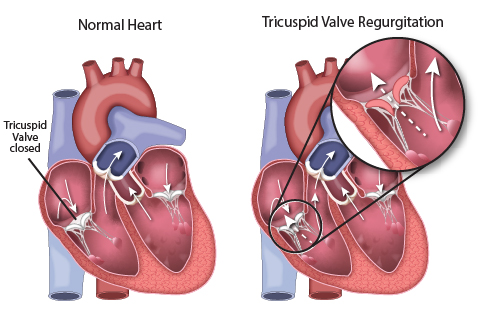 Your tricuspid valve separates your heart’s right ventricle (your heart’s lower right chamber) from your heart’s right atrium (your heart’s upper right chamber). Tricuspid valve regurgitation, which is a type of valvular heart disease, occurs when the tricuspid valve does not close completely. As a result, some blood leaks backward into the right atrium, decreasing the efficiency of blood flow to the lungs.
Your tricuspid valve separates your heart’s right ventricle (your heart’s lower right chamber) from your heart’s right atrium (your heart’s upper right chamber). Tricuspid valve regurgitation, which is a type of valvular heart disease, occurs when the tricuspid valve does not close completely. As a result, some blood leaks backward into the right atrium, decreasing the efficiency of blood flow to the lungs.
Symptoms of tricuspid valve regurgitation are not always noticeable. However, as your body is deprived of oxygen because it is not receiving enough blood from the heart, you and your doctor may begin to see signs of the cardiac condition, including:
- Enlarged liver
- Pulsation in the veins of your neck
- Swelling in your abdomen
- Swelling in your ankles, feet and/or legs
Tricuspid valve regurgitation is most commonly caused by enlargement of the right ventricle. This enlargement occurs when the ventricle is under excessive pressure caused by various factors, including:
- Carcinoid tumors, a type of neuroendocrine tumor that grows slowly
- Heart complications that impair the function of the left side of the heart
- High blood pressure, especially when it is a result of a blood clot or chronic obstructive pulmonary disease
- Infections, such as rheumatic fever and infection of the tricuspid valve
- Marfan syndrome, which impacts your connective tissue
- Other valve disorders in the heart
- Radiation therapy
- Rheumatoid arthritis, a chronic autoimmune disease affecting the joints
Your first visit to the structural heart program at the UK Gill Heart & Vascular Institute will be a meeting that often takes only an hour. During this appointment, you will meet your care team, including:
- Your interventional cardiologist, a specialist who uses catheter-based procedures to diagnose and treat heart issues
- An advanced practice provider, (a physician assistant or nurse practitioner)
- A nurse coordinator
- A patient navigator, who works with you to help ensure that your healthcare needs are met
If you need imaging, you will be scheduled for a follow-up visit at this time.
For the visit:
- Wear comfortable clothing.
- Bring your insurance information. While UK HealthCare accepts all insurers, not every insurer is in network.
- Bring a list of all medicines and supplements you currently take.
- You may find it helpful to have a family member or friend with you at this visit.
Where we are located
The UK Gill Heart & Vascular Institute is located at 800 Rose St. in Pavilion G, on the first floor of UK Albert B. Chandler Hospital. We will mail you a map and directions when your appointment is scheduled.
Patient drop-off
Patients can be dropped off in front of the main entrance to Albert B. Chandler Hospital at 1000 S. Limestone. If you are dropped off at the main entrance, you’ll enter the revolving doors on the ground floor of the hospital. Take the main stairs just to the left (or elevator across the atrium) to the first floor of Pavilion A.
After climbing the stairs or taking the elevator, turn left. You’ll pass the Kentucky Wall and Kentucky Children’s Hospital on your right. Continue to the end of the hall until it comes to a T shape. Turn left and the Gill clinic entrance is across from an open area housing the organ donor wall.
Parking
It is easiest to park in the UK HealthCare Parking Garage, across from the hospital at 110 Transcript Ave.
There are two paths from this garage to the Gill clinic:
- You may take the free shuttle from Level A of the parking garage. You’ll exit the shuttle at the Pavilion A/ Pavilion G stop in front of the main entrance to the hospital. After climbing the stairs or taking the elevator, turn left. You’ll pass the Kentucky Wall and Kentucky Children’s Hospital on your right. Continue to the end of the hall until it comes to a T shape. Turn left and the Gill clinic entrance is across from an open area housing the organ donor wall.
- From Level C of the parking garage you may walk or take a golf cart across the pedway to the first floor of Pavilion A. Turn left past the help desk and walk away from the dining hall. You’ll pass the Kentucky Wall and Kentucky Children’s Hospital on your right. Continue to the end of the hall until it comes to a T shape. Turn left and the Gill clinic entrance is across from an open area housing the organ donor wall.
If you need help finding your way, information desks are located inside the main entrances to Pavilion A, both on the ground floor and at the end of the pedway on the first floor. You may also call the information desk at 859-323-5816.
The UK Gill Heart & Vascular Institute’s structural heart program offers patients access to advanced clinical trials. Our Cardiology Clinical Research Center gives structural heart disease patients a chance to try new technologies years before they are available to the general public. These innovative and potentially lifesaving procedures are not available at other facilities in the region.









